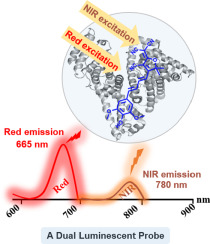当前位置:
X-MOL 学术
›
Spectrochim. Acta. A Mol. Biomol. Spectrosc.
›
论文详情
Our official English website, www.x-mol.net, welcomes your feedback! (Note: you will need to create a separate account there.)
Dual luminescent charge transfer probe for quantitative detection of serum albumin in aqueous samples.
Spectrochimica Acta Part A: Molecular and Biomolecular Spectroscopy ( IF 4.4 ) Pub Date : 2020-03-24 , DOI: 10.1016/j.saa.2020.118305 Rajib Choudhury 1 , Benjamin Quattlebaum 1 , Charles Conkin 1 , Siddhi Rajeshbhai Patel 1 , Kallie Mendenhall 1
Spectrochimica Acta Part A: Molecular and Biomolecular Spectroscopy ( IF 4.4 ) Pub Date : 2020-03-24 , DOI: 10.1016/j.saa.2020.118305 Rajib Choudhury 1 , Benjamin Quattlebaum 1 , Charles Conkin 1 , Siddhi Rajeshbhai Patel 1 , Kallie Mendenhall 1
Affiliation

|
In diagnostic medicine serum albumin is considered as an important biomarker for assessment of cardiovascular functions and diagnosis of renal diseases. Herein, we report a novel donor-π-π-acceptor fluorophore for selective detection of serum albumin in urine samples. In our design, a phenolic donor was conjugated with a tricyanofuran (TCF) acceptor through a dimethine bridge via a simple condensation reaction. The stereoelectronic effects of the incorporated methoxy (-OCH3) groups and the TCF moiety-in conjunction with the extended π-electron conjugation-led to dual red and NIR-I absorption/emission in water. Moreover, due to superior electron transfer between a phenolate donor and the TCF acceptor and the subsequent energy decay from the charge transfer states, the fluorophore displayed negligible fluorescence emission in water and other polar solvents. Consequently, we have been able to utilize the fluorophore for quantitative estimation of serum albumin both in the red (<700 nm) and NIR-I (700-900 nm) regions of the electromagnetic spectrum with excellent reproducibility. The fluorophore selectively recognized human serum albumin over other proteins and enzymes with a limit of detection of 10 mg/L and 20 mg/L in simulated urine samples at red and NIR-I emission window of the spectrum, respectively. By molecular docking analysis and experimental displacement assays, we have shown that the selective response of the fluorophore toward human serum albumin is due to tighter supramolecular complexation between the fluorophore and the protein at subdomain IB, and the origin of the NIR-I (780 nm) emission was attributed to a twisted conformer of phenolate-π-π-TCF system in aqueous solution. These findings indicate that the fluorophore could be utilized for quantitative detection of human serum albumin in urine samples for clinical diagnosis of albuminuria.
中文翻译:

双发光电荷转移探针,用于定量检测水性样品中的血清白蛋白。
在诊断医学中,血清白蛋白被认为是评估心血管功能和诊断肾脏疾病的重要生物标志物。在这里,我们报告了一种新型的供体-π-π-受体荧光团,用于选择性检测尿液样品中的血清白蛋白。在我们的设计中,酚供体通过简单的缩合反应通过二甲胺桥与三氰呋喃(TCF)受体结合。结合的甲氧基(-OCH3)基团和TCF部分的立体电子效应与扩展的π电子共轭作用共同导致水中的红色和NIR-1双重吸收/发射。此外,由于酚酸酯供体与TCF受体之间的电子转移非常出色,并且随后的能量从电荷转移态开始衰减,荧光团在水和其他极性溶剂中的荧光发射可忽略不计。因此,我们已经能够利用荧光团以极好的可重复性对电磁光谱的红色(<700 nm)和NIR-1(700-900 nm)区域的血清白蛋白进行定量估计。荧光团选择性地识别人血清白蛋白超过其他蛋白质和酶,在光谱的红色和NIR-1发射窗口处的模拟尿样中的检出限分别为10 mg / L和20 mg / L。通过分子对接分析和实验位移分析,我们已经表明,荧光团对人血清白蛋白的选择性反应是由于荧光团和亚结构域IB处的蛋白质之间的超分子络合更加紧密,NIR-1(780 nm)发射的起源归因于水溶液中酚盐-π-π-TCF体系的扭曲构象。这些发现表明该荧光团可用于定量检测尿液样品中的人血清白蛋白,以用于临床诊断蛋白尿。
更新日期:2020-03-26
中文翻译:

双发光电荷转移探针,用于定量检测水性样品中的血清白蛋白。
在诊断医学中,血清白蛋白被认为是评估心血管功能和诊断肾脏疾病的重要生物标志物。在这里,我们报告了一种新型的供体-π-π-受体荧光团,用于选择性检测尿液样品中的血清白蛋白。在我们的设计中,酚供体通过简单的缩合反应通过二甲胺桥与三氰呋喃(TCF)受体结合。结合的甲氧基(-OCH3)基团和TCF部分的立体电子效应与扩展的π电子共轭作用共同导致水中的红色和NIR-1双重吸收/发射。此外,由于酚酸酯供体与TCF受体之间的电子转移非常出色,并且随后的能量从电荷转移态开始衰减,荧光团在水和其他极性溶剂中的荧光发射可忽略不计。因此,我们已经能够利用荧光团以极好的可重复性对电磁光谱的红色(<700 nm)和NIR-1(700-900 nm)区域的血清白蛋白进行定量估计。荧光团选择性地识别人血清白蛋白超过其他蛋白质和酶,在光谱的红色和NIR-1发射窗口处的模拟尿样中的检出限分别为10 mg / L和20 mg / L。通过分子对接分析和实验位移分析,我们已经表明,荧光团对人血清白蛋白的选择性反应是由于荧光团和亚结构域IB处的蛋白质之间的超分子络合更加紧密,NIR-1(780 nm)发射的起源归因于水溶液中酚盐-π-π-TCF体系的扭曲构象。这些发现表明该荧光团可用于定量检测尿液样品中的人血清白蛋白,以用于临床诊断蛋白尿。



























 京公网安备 11010802027423号
京公网安备 11010802027423号